[ Download ]
The picture of these spearheads was posted on facebook by Claíomh, a Dublin based Gallóglaigh re-enactment group. The spearheads are in the Ulster museum and are dated to the 12th - 14th centuries and are about 10 inches long. I’ve never seen anything quite like them - are they spearheads, javelins, lances or something else? One guy on face book suggested that the form was to pierce mail similar to that of a bodkin. Are there other similar styles of spearhead out there?
 Attachment: 45.56 KB
Attachment: 45.56 KB
[ Download ]
[ Download ]
He is right, the look exactly like the type ten bodkins heads. But I think you are right, at 10" there is no way these were for bows. I wonder what the diameter of the shoulder is.
Recently I have been very interested in finding a small forge to make small things like this with. I'd love to see how they would work. Since Javelins remain common in a few places like Ireland throughout much of the Medieval period, if not the entire period that would be a logical conclusion if the shoulder is wider than an arrow.
RPM
Recently I have been very interested in finding a small forge to make small things like this with. I'd love to see how they would work. Since Javelins remain common in a few places like Ireland throughout much of the Medieval period, if not the entire period that would be a logical conclusion if the shoulder is wider than an arrow.
RPM
I kind of thought that they might be heads of the darts the kern used.
I'm gonna agree with Zach and say dart heads.
Later medieval European javelin heads seem to be large, broad and barbed, judging from contemporary artwork. One 17th c. portrait shows a very light Irish javelin with a small barbed head. In this discussion-- http://www.myArmoury.com/talk/viewtopic.php?t...ight=darts --Mathew Kelty mentions Irish living history folks using "pyramidal" heads, which seems in line with the examples from Ulster although I envisioned something shorter than those.
I think these could be javelin heads, but they also might be lance heads, which tend to be between arrowheads and the larger infantry spear heads in terms of size. Derrick is pretty vague about weapon forms but you can see his depiction of Irish lances below.
Keep in mind that all of these images post-date the Ulster head range by about 200 years.
 Attachment: 108.39 KB
Attachment: 108.39 KB
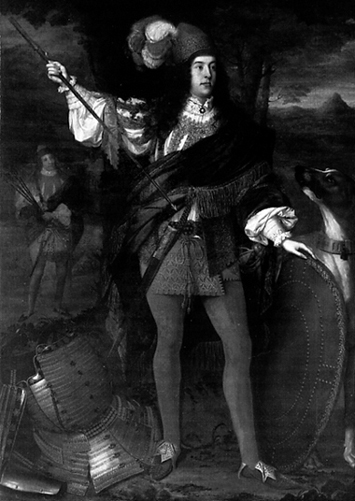
 Attachment: 207.12 KB
Attachment: 207.12 KB

 Attachment: 203.74 KB
Attachment: 203.74 KB
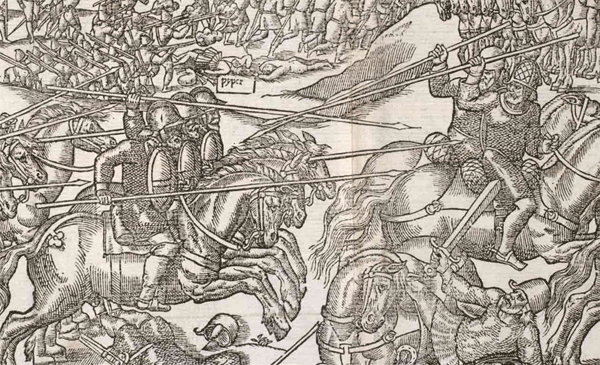
I think these could be javelin heads, but they also might be lance heads, which tend to be between arrowheads and the larger infantry spear heads in terms of size. Derrick is pretty vague about weapon forms but you can see his depiction of Irish lances below.
Keep in mind that all of these images post-date the Ulster head range by about 200 years.



Last edited by Sean Flynt on Fri 27 Apr, 2012 8:49 am; edited 2 times in total
I wouldn't question the museum's dating without good cause, but the first thing I thought when I saw the example at far left in that photo was "that resembles an English leading staff head of the late 16th/early 17th c."
I don't think that's what it is--the section isn't quite like the one shown below, based on a Va. find, but it could pass. It even has the typical raised rounded band just below the blade. That head is also finely finished compared to the other two. It definitely has a more complex socket with incised decoration. The swelling appears to be roped, but that may be a result of corrosion or shadows. The open socket of the head at far right argues for a purely utilitarian field use.
There's at least one modern reproduction javelin head that uses this robust square section--A&A's Eastern European javelin.
 Attachment: 126.07 KB
Attachment: 126.07 KB
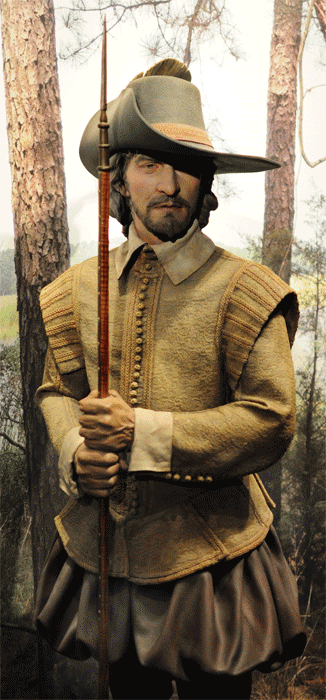
 Attachment: 151.3 KB
Attachment: 151.3 KB
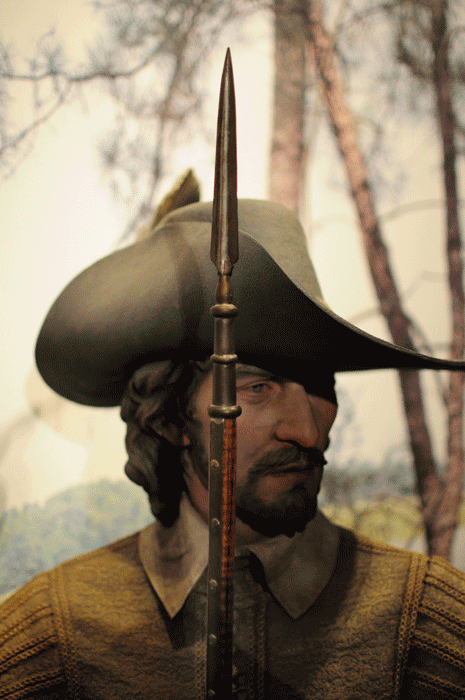
 Attachment: 24.45 KB
Attachment: 24.45 KB
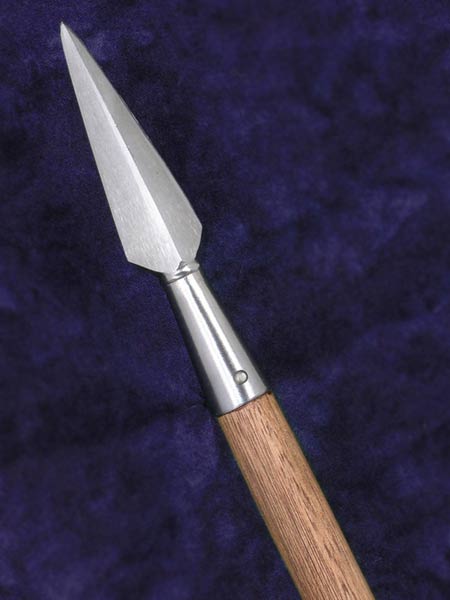
I don't think that's what it is--the section isn't quite like the one shown below, based on a Va. find, but it could pass. It even has the typical raised rounded band just below the blade. That head is also finely finished compared to the other two. It definitely has a more complex socket with incised decoration. The swelling appears to be roped, but that may be a result of corrosion or shadows. The open socket of the head at far right argues for a purely utilitarian field use.
There's at least one modern reproduction javelin head that uses this robust square section--A&A's Eastern European javelin.



With not context, my guesses would be, in order,
lance head (it's a very common and widespread lance head design)
pike head
spear/pike butt
and then if pressed for another guess, perhaps javelin head.
(I wouldn't guess Irish lance head, but Turkish/Persian.)
lance head (it's a very common and widespread lance head design)
pike head
spear/pike butt
and then if pressed for another guess, perhaps javelin head.
(I wouldn't guess Irish lance head, but Turkish/Persian.)
As much as I don’t want to lightly question the dating by the museum, if it were not for that dating, I would suggest that they are almost identical to pike heads from the 16th to 19th centuries. In the article “The Irish Pike” by G. A. Hayes-McCoy he quotes a writer from the 17th century who says:
"The Irish pikes, were longer by a foot or two than the Scottish pikes, and far better to pierce, being four square and small..”
Also: “A correspondent of the Nation (June 24, 1848, 408) advises pikes like army lances, with heads ten inches long, an inch and a quarter broad and sharpened as carefully as a dagger.”
Hayes-McCoy says: “Some of the pikes made for the Irish Volunteers before 1916 were fitted with a head of square section.”
An accompanying diagram of a pre-1916 pike head looks very similar to the photos. It seems that the form of the Irish pike was very distinctive and quite different from that of the English or Scottish.
This would also tie in with Sean's suggestion that the far left head suggestion that the far left head “resembles an English leading staff head of the late 16th/early 17th c”.
Its only putting an idea out there. As I said, if it weren’t for that dating I think that they would be a pretty good match for a 16th or 17thC or even later, Irish pike.
 Attachment: 78.98 KB
Attachment: 78.98 KB
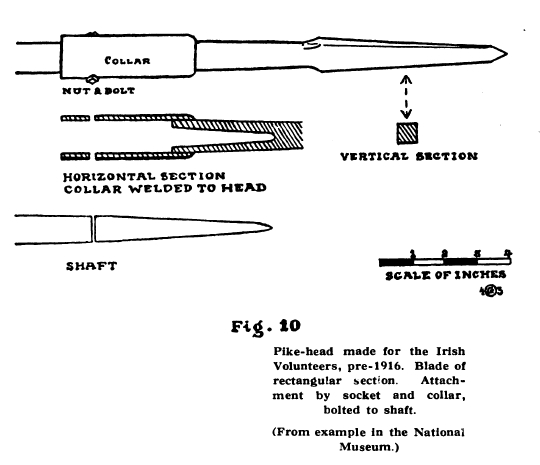
 Attachment: 72.82 KB
Attachment: 72.82 KB

"The Irish pikes, were longer by a foot or two than the Scottish pikes, and far better to pierce, being four square and small..”
Also: “A correspondent of the Nation (June 24, 1848, 408) advises pikes like army lances, with heads ten inches long, an inch and a quarter broad and sharpened as carefully as a dagger.”
Hayes-McCoy says: “Some of the pikes made for the Irish Volunteers before 1916 were fitted with a head of square section.”
An accompanying diagram of a pre-1916 pike head looks very similar to the photos. It seems that the form of the Irish pike was very distinctive and quite different from that of the English or Scottish.
This would also tie in with Sean's suggestion that the far left head suggestion that the far left head “resembles an English leading staff head of the late 16th/early 17th c”.
Its only putting an idea out there. As I said, if it weren’t for that dating I think that they would be a pretty good match for a 16th or 17thC or even later, Irish pike.


Page 1 of 1
You cannot post new topics in this forumYou cannot reply to topics in this forum
You cannot edit your posts in this forum
You cannot delete your posts in this forum
You cannot vote in polls in this forum
You cannot attach files in this forum
You can download files in this forum
All contents © Copyright 2003-2006 myArmoury.com — All rights reserved
Discussion forums powered by phpBB © The phpBB Group
Switch to the Full-featured Version of the forum
Discussion forums powered by phpBB © The phpBB Group
Switch to the Full-featured Version of the forum